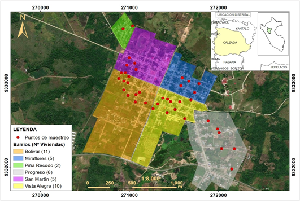Carbon monoxide in interior spaces and its relationship with the consumption of firewood
DOI:
https://doi.org/10.51252/reacae.v1i2.379Keywords:
pollution, air, gases, family healthAbstract
This study consisted of determining the carbon monoxide concentration (CO) and its relationship with the consumption of firewood in 39 dwellings distributed in 6 neighbourhoods in the urban area in Calzada city. During one week and at three times of the day, the CO concentration in each house was measured with the measuring device model TROTEC BG20 and the firewood was randomly quantified by direct counting. The difference in CO concentrations and fuelwood consumption between the neighbourhoods was analysed. The cluster analysis showed differences in the distribution of CO composition and fuelwood concentrations across neighbourhoods and days of the week. It was also determined that the consumption of firewood/person and the number of persons per household did not influence CO concentrations. It is expected that for one additional kilogram of firewood consumed by one person, CO would increase by 442.62 ppm, and if one person is added to each family, it would increase by 55.85 ppm. The increase in households depending on firewood for cooking would increase CO emissions in poorly ventilated rural homes.
Downloads
References
Aguilar, M. (2002). Indoor, Outdoors and in Transit Exposure To Carbon Monoxide in Trujillo, Peru. Asociacion Del Aire Ambiental, 1, 459–464. https://trid.trb.org/view/735197
Alosilla Castillo, Y. N. (2014). Problemática ambiental de las concentraciones de monóxido de carbono en viviendas del sector de Camata del distrito de Plateria provincia de Puno 2013 [Universidad Privada San Carlos Puno]. http://repositorio.upsc.edu.pe/handle/UPSC/4440
Carazo Fernández, L., Fernández Alvarez, R., González-Barcala, F. J., & Rodríguez Portal, J. A. (2013). Contaminación del aire interior y su impacto en la patología respiratoria. Archivos de Bronconeumología, 49(1), 22–27. https://doi.org/10.1016/j.arbres.2012.04.005
Chavarría Rosales, A. G. (2015). Relación entre el nivel de monóxido de carbono intradomiciliar y función pulmonar [Universidad Rafael Landivár]. http://recursosbiblio.url.edu.gt/tesisjcem/2015/09/03/Chavarria-Ana.pdf
Coffey, E. R., Pfotenhauer, D., Mukherjee, A., Agao, D., Moro, A., Dalaba, M., Begay, T., Banacos, N., Oduro, A., Dickinson, K. L., & Hannigan, M. P. (2019). Kitchen Area Air Quality Measurements in Northern Ghana: Evaluating the Performance of a Low-Cost Particulate Sensor within a Household Energy Study. Atmosphere, 10(7), e400. https://doi.org/10.3390/atmos10070400
Forero Garzón, Y. (2021). La calidad del aire interior y su incidencia en la salud de las personas. [Universidad Militar Nueva Granada]. https://repository.unimilitar.edu.co/handle/10654/40242
Grewal, A., Abbey, Lord, & Gunupuru, L. R. (2018). Production, prospects and potential application of pyroligneous acid in agriculture. Journal of Analytical and Applied Pyrolysis, 135, 152–159. https://doi.org/10.1016/j.jaap.2018.09.008
INEI. (2018). Censos Nacionales 2017 – XII de Población, VII de Vivienda y III de Comunidades Indígenas. http://censo2017.inei.gob.pe/
INEI. (2019). Hogares en los que cocinan con combustibles contaminantes. www.inei.gob.pe
Motta, F. ., Salas Plata, J. ., Quevedo, H. ., & Velásquez, G. . (2015). Efectos en la salud humana debido a la contaminación interior por Monóxido de Carbono en Ciudad Juárez, Chihuahua. Cultura Científica Y Tecnológica, 20. http://erevistas.uacj.mx/ojs/index.php/culcyt/article/view/446
Nakora, N., Byamugisha, D., & Birungi, G. (2020). Indoor air quality in rural Southwestern Uganda: particulate matter, heavy metals and carbon monoxide in kitchens using charcoal fuel in Mbarara Municipality. SN Applied Sciences, 2(12), e2037. https://doi.org/10.1007/s42452-020-03800-0
Nyombi, A., Williams, M. R., & Wessling, R. (2020). Toxic emissions from smouldering combustion of woody biomass and derived char with a case study of CO build-up in an ISO container. Energy Sources, 42(24), 2990–3007. https://doi.org/10.1080/15567036.2019.1623348
OMS. (2021). Contaminación del aire doméstico y salud. Contaminación Del Aire Doméstico y Salud. https://www.who.int/es/news-room/fact-sheets/detail/household-air-pollution-and-health
Pimenta, A. S., Fasciotti, M., Monteiro, T. V. C., & Lima, K. M. (2018). Chemical Composition of Pyroligneous Acid Obtained from Eucalyptus GG100 Clone. Molecules, 23(2), 426. https://doi.org/10.3390/MOLECULES23020426
Raw, G. J., Coward, S. K. D., Brown, V. M., & Crump, D. R. (2004). Exposure to air pollutants in English homes. Journal of Exposure Science & Environmental Epidemiology, 14(S1), S85–S94. https://doi.org/10.1038/sj.jea.7500363
Sabater, V. (2020). La contaminación del aire en los espacios interiores: un peligro para tu salud - Mejor con Salud. La Contaminación Del Aire En Los Espacios Interiores y Sus Efectos. https://mejorconsalud.as.com/contaminacion-aire-espacios-interiores-peligro-salud/
Tika Ram, P., & Hom Bahadur, R. (2020). Hourly Firewood Consumption Patterns and CO2 Emission Patterns in Rural Households of Nepal. Designs, 4(4), 46. https://doi.org/10.3390/designs4040046

Published
How to Cite
Issue
Section
License
Copyright (c) 2022 Marimar Sánchez-Imaña, Alfonso Rojas-Bardález, Jhon Jairo López-Rojas, Miguel Guerra-Saldaña, Diego Velasquez-Garcia

This work is licensed under a Creative Commons Attribution 4.0 International License.
The authors retain their rights:
a. The authors retain their trademark and patent rights, as well as any process or procedure described in the article.
b. The authors retain the right to share, copy, distribute, execute and publicly communicate the article published in the Revista Amazónica de Ciencias Ambientales y Ecológicas (REACAE) (for example, place it in an institutional repository or publish it in a book), with an acknowledgment of its initial publication in the REACAE.
c. Authors retain the right to make a subsequent publication of their work, to use the article or any part of it (for example: a compilation of their works, notes for conferences, thesis, or for a book), provided that they indicate the source of publication (authors of the work, journal, volume, number and date).



